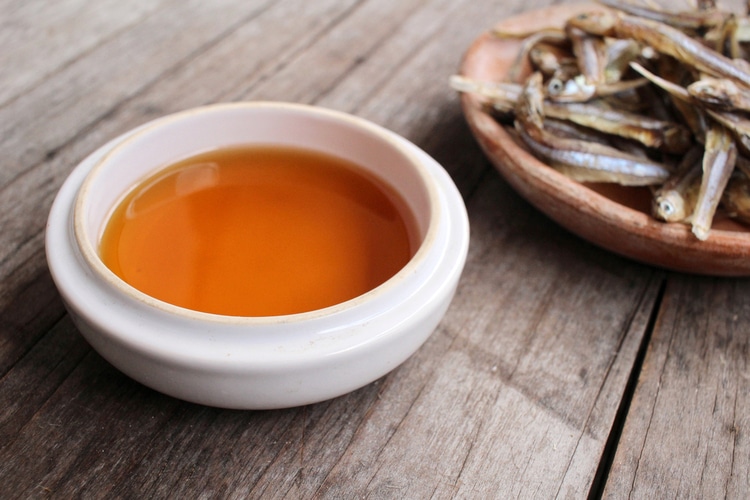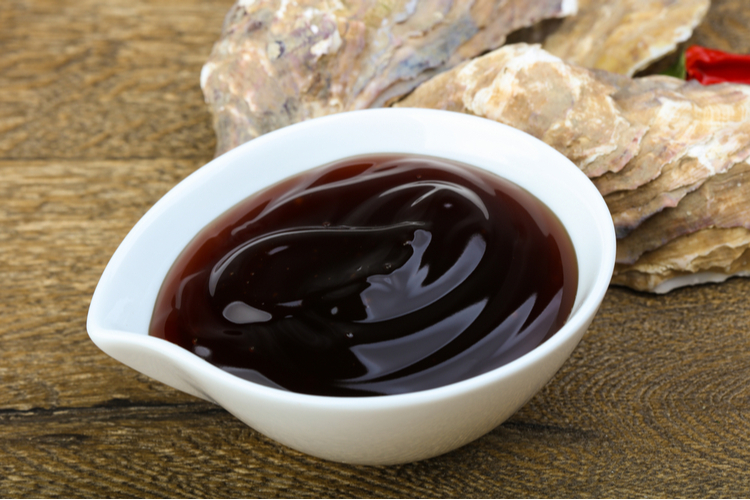Both fish sauce and oyster sauce are used in Chinese cuisine today. Fish sauce was used widely in ancient Mediterranean cuisine, being recorded back to 4th-3rd century BC by ancient Greece.
Oyster sauce is much more modern relative to fish sauce. It was first made in 1888 by a restauranteur named Mr. Lee Kum Sheung from Southern China.
His oyster soup was forgotten, simmering down to a thick gravy. Instead of throwing away his oyster syrup, he tasted it and discovered this beloved sauce. These sauces give stir-fry its unique flavor.
Despite their similar names, fish sauce and oyster sauce do not have very similar flavors. Fish sauce is much fishier than oyster sauce, which has more of a sweet, earthy flavor.
Difference Between Fish and Oyster Sauce
The main difference between fish sauce and oyster sauce is what they are composed of. Fish sauce is typically made with the juice of fermented anchovies and salt, while the oyster sauce is made from the caramelized juice of cooked oysters, sugar, and salt.
These are different ingredients and methods of obtaining these sauces, giving them different flavors and different uses in Asian cuisine.
Appearance: Fish sauce is a rich, reddish-golden brown translucent color, while oyster sauce is a dark brown, almost black color.
Consistency: Fish sauce has a thin, watery consistency. Oyster sauce is thick and syrup-like.
Acquiring Method: Fish sauce is made by the fermenting of salted fish with no heat. This is a long process, taking 3-12 months to complete. The liquid containing fish extract that is obtained in this process is the fish sauce itself.
Traditionally, oyster sauce was made in the slow process of simmering oysters in water over low heat for hours, until the liquid caramelized and reduced into the flavorful sauce. Today, thickeners such as cornstarch are used to speed up the process of making oyster sauce.
Flavor: Fish sauce can be described as an umami flavor. Salty, earthy, savory, fishy, briny notes with sweet and tangy undertones give fish sauce its distinct flavor. Oyster sauce does not have so much of a fishy flavor, but rather has a deep caramelized flavor. Oyster sauce is also more salty and sweet than fish sauce.
Aroma: Fish sauce has a more pungent fishy smell than oyster sauce. It smells fishier than it tastes. Oyster sauce has an earthy, salty smell to it.
Shelf Life: Fish sauce has a longer shelf life than its competitor oyster sauce. Fish sauce can last 3 to 4 years on your pantry shelves, while oyster sauce will only last you 18 to 24 months.
Cost: Fish sauce is considerably more expensive than oyster sauce. At a local market, a 6.76 fl oz bottle of fish sauce costs $3.13, while a 9 fl oz bottle of oyster sauce is only $2.68.
Uses: Fish sauce is typically used in stir-fries, soups, marinades, braised meats, pasta sauces, vinaigrettes, and yogurt dips. Oyster sauce is commonly used as a part of a stir-fry, but it is also a common ingredient in Asian barbeque sauce, as a marinade, or a glazing sauce.
Origination: Fish sauce can be traced back to the Ancient Greeks, quickly spreading to Ancient China. Oyster sauce originated in southern China and spread to Khmer, Vietnamese, and Thai cuisines.
Ingredients: Fish sauce is made with brine from fermented fish, spices such as peppercorns, garlic, sea salt, bay leaves, and lemon. Oyster sauce is typically made with caramelized juice of simmering oysters, salt, sugar, corn starch, and spices.
Fish vs Oyster Sauce Comparison Table
| Fish Sauce | Oyster Sauce | |
| Appearance | Translucent, brown | Dark brown/black |
| Consistency | Thin and watery | Thick, syrup-like |
| Acquiring Method | Fermentation | Simmering |
| Flavor | Fishy, salty, briny, tangy | Sweet, salty, earthy |
| Aroma | Fishy | Carmelized |
| Ingredients | Fish, spices, brine | Oysters, salt, sugar |
| Uses | Stir-fry, marinades, soups | Marinades, stir-fry, bbq |
| Origination | Ancient Greece | Southern China |
| Cost | $3.13 for 6.76 fl oz | $2.68 for 9 fl oz |
| Shelf Life | 3 to 4 years | 18 to 24 months |
Can You Substitute Fish Sauce for Oyster Sauce?
Many have asked, can you substitute fish sauce for oyster sauce and vice versa. The short answer is yes. If you use fish sauce instead of oyster sauce, the resulting dish may have the wrong consistency, be too salty and tangy.
It is recommended that you use less fish sauce if the recipe calls for oyster sauce because of the salt levels.
If the recipe calls for fish sauce, using oyster sauce as a substitute may give the dish a more sweet flavor, and you may want to add more salt or even some soy sauce.
If you are making a stir-fry and only have one sauce or the other, either sauce you put into your dish will result in a delicious meal. Remember to adjust some of your other ingredients to get the best tasting resulting dish.
If you are making a dish that contains fish and the recipe calls for fish sauce and you use oyster sauce, no big deal. If you are making a dish that does not have fish and you substitute fish sauce for oyster sauce, be prepared for a bit of a fishy taste.
It is recommended not to substitute fish sauce for oyster sauce in non-fish dishes.
Related Comparison: Hoisin vs Oyster Sauce Differences
What is Fish Sauce?

Fish sauce is a condiment made from fermented anchovies and salt. In countries such as Thailand, Cambodia, and the Philippines of Southeast Asia, it is evident that fish sauce plays a crucial role in flavoring food.
Even though it is so prominent in Asian cuisine, the first record of fish sauce comes from the ancient Greeks in Roman times. Claudio Giardino, an Italian archaeologist, noted that garum (a name for fish sauce) was found in Roman literature from the 4th century BC.
Remains have been found in Spain, Northern Africa, and Portugal of garum factories.
Pompeii was also known for its production of fish sauce in ancient times. Some historians believe that the idea of fermenting fish with salt occurred independently in both the East and the West. The well-known Asian fish sauce is thought to have originated in Vietnam soon after the Greeks.
The Vietnamese fish sauce was a derivative of Chinese soy sauce when the fish was fermented with soybeans.
No matter its history, fish sauce is pretty simple. Fish is fermented for months in a 4:1 ratio with salt. This mixture is left to ferment, producing the sauce we all call fish sauce today.
If one were to look on the internet, you can find many recipes with added ingredients and spices. These can all be considered fish sauce, but the original fish sauce had just two recipes: anchovies and salt.
How to Use Fish Sauce
Fish sauce is a versatile condiment, adding umami and savory notes to every dish it is put in. It is used in dipping sauces, vinaigrettes, marinades, sauces, braises, soups, pasta sauces, curries, barbeque sauce, and stir-fries. It is a great salt substitute and gives your dish a bit of a tangy flavor.
It is best to use fish sauce when you want to give your dish a bit of an Asian flair.
What is Oyster Sauce?

Oyster sauce is a sweet and salty condiment composed of caramelized oyster juices, salt, and sugar. Created by accident in 1888, oyster sauce has become a favorite in Chinese and Thai cuisines. Compared to other sauces in Asian culture, oyster sauce is a young staple condiment.
One day in a teahouse in Guangdong, chef Lee Kum Sheung accidentally left his oysters on the stove for hours. Rushing to check on his dish, he found a thick, brown paste that had reduced from the juices from the oysters. Instead of throwing it out, he gave it a taste. He realized how delicious it was; thus, oyster sauce was born.
Today, there are multiple types of oyster sauce. With such high demand, manufacturing companies have steered away from the original way of making oyster sauce which takes hours.
They have opted for more efficient ways of producing the condiment, using coloring and cornstarch for thickening. You can also find a vegetarian version made from mushrooms.
How to Use Oyster Sauce
Adding oyster sauce to your dishes gives a delicious umami flavor. It is commonly used in stir-fries, dipping sauces, marinades, Asian barbeque sauce, and glazing sauces. Oyster sauce can also be used straight out of the bottle as a sauce for things like spring rolls and egg rolls.
Add oyster sauce to any dish to add a salty, earthy flavor. Below is a recipe using oyster sauce that showcases its flavor.






